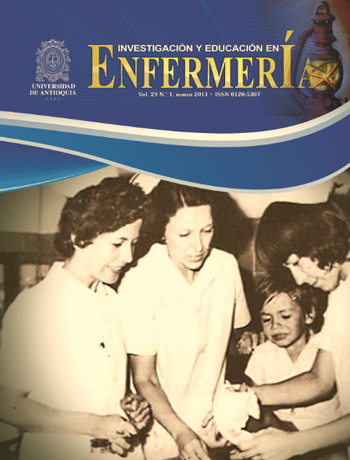Strategies to solve questions about clinical practice in nursing and medicine professionals in Bolivia and Colombia
DOI:
https://doi.org/10.17533/udea.iee.8530Keywords:
Evidence-based medicine; evidence-based nursing; health personnel; information science.Abstract
Objective. To describe strategies to solve questions about clinical practice in nursing and medicine professionals who attend training courses in sexual and reproductive health in Bolivia and Colombia.
Methodology. Transversal cut study. Information was collected between March of 2007 and February 201, an anonymous voluntary self-applied survey was used.
Results. Of 563 participants, 292 were nursing professionals and 271 were doctors. 60%were women. Age average: 34 years old (Rank: 25-92). 80% of the participants worked in public institutions. 70% of them believe their knowledge has decreased, updating strategies are: 75% colleagues consult, 24% check their books and magazines, and even though 88% use the internet, just 7.6% access data bases.
Conclusion. Updating traditional strategies remain. There is a few knowledge evidence-based strategies and a big ignorance on data bases use. It is necessary to implement strategies to train towards the efficient use of them; it allows updating and improves healthcare quality.
Downloads
References
(1) Isaza A. Clases magistrales versus actividades participativas en el pregrado de medicina. De la teoría a la evidencia. Rev Estud Soc. 2005;20:83-91.
(2) Hernández AR. Las guías de práctica clínica en la atención médica. Rev Cubana Ortop Traumatol. 2008;22(2). [acceso3 de julio de 2010]. Disponible en: http://scielo.sld.cu/scielo.php?script=sci_ arttext&pid=S0864-215X2008000200006&lng =pt&nrm=iso&tlng=es
(3) Gómez PI. Uso de simuladores y otras ayudas educativas en Medicina. Rev Fac Med. 2003; 51(4):227-32.
(4) Evidence-Based Medicine Working Group. Evidence-based medicine. A new approach to teaching the practice of medicine. JAMA 1992;268(17):2420–5.
(5) Dawes MG. On the need for evidence-based general and family practice. Evid Based Med. 1996;1:68-9.
(6) Curso de Medicina basada en la evidencia [Internet]. [Consultado 2010 Jul 5]. Disponible en: http://www.tema-e.com.ar/MBE_DT/Objetivos.htm
(7) Sackett DL, Haynes RB, Guyatt GH, Tugwell P. Epidemiología Clínica, una ciencia básica para la medicina clínica. 2. ed. Buenos Aires: Editorial Panamericana; 1994.
(8) Saavedra O. La producción hemerográfica en ciencias de la salud: estado actual y perspectivas. ACIMED. 1995;3(2):13-23.
(9) Ebell MH, Siwek J, Weiss BD, Woolf SH, Susman J, Ewigman B, et al. Strength of Recommendation Taxonomy (SORT): a patient-centered approach to grading evidence in the medical literature. Am Fam Physician. 2004;69(3):548-56.
(10) Gómez PI. Conceptos Básicos de Epidemiología Clínica. La Paz: Acquire Project, USAID; 2007:4-12.
(11) Al-Omari FK, Al-Asmary SM. Attitude, awareness and practice of evidence based medicine among consultant physicians in Western region of Saudi Arabia. Saudi Med J. 2006; 27(12):1887–93.
(12) Amin FA, Fedorowicz Z, Montgomery AJ. A study of knowledge and attitudes toward the use of evidence-based medicine among primary health care physicians in Bahrain. Saudi Med J. 2006;27(9):1394–6.
(13) Young JM, Ward JE. Evidence-based medicine in general practice: beliefs and barriers among Australian GPs. J Eval Clin Pract. 2001;7(2):201–10.
(14) Kilian BJ, Binder LS, Marsden J. The emergency physician and knowledge transfer: continuing medical education, continuing professional development, and self-improvement. Acad Emerg Med. 2007; (14): 1003-7.
(15) Phua J, Lim TK. Use of traditional versus electronic medical-information resources by residents and interns. Med Teach. 2007; (29): 400-2.
(16) Tannery NH, Foust JE, Gregg AL, Hartman LM, Kuller AB, Worona P, et al. Use of Web-based library resources by medical students in community and ambulatory settings. J Med Libr Assoc. 2002;(90): 305-9.
(17) Tang H, Hwee Kwoon J. Googling for a diagnosisuse of Google as a diagnostic aid: internet based study. BMJ 2006;(333):1143-5.
(18) Copa A. Bolivia aún con bajo acceso a Internet. El Deber. 2008 May 10; sección “Economía” (col 1). [acceso 7 de junio de 2010]. Disponible en: http://www.eldeber.com.bo/2008/2008-05-16/ vernotaeconomia.php?id=080515204814
Downloads
Published
How to Cite
Issue
Section
License
Derechos de propiedad / Direitos de Propriedade
English: If the article is accepted for publication, all copyright will be of exclusive property of Investigación y Educación en Enfermería. The text and the graphics included in the publication are exclusive responsibility of the authors and not necessarily reflect the thought of the Editorial Committee.
Español: Si el artículo es aprobado para publicación, todos los derechos son de propiedad de Investigación y Educación en Enfermería. El texto y las gráficas incluidas en la publicación son de exclusiva responsabilidad de los autores y no necesariamente refleja el pensamiento del Comité Editorial.
Português: Se o artigo for aceito para publicação, todos os direitos autorais serão de propriedade exclusiva de Investigación y Educación en Enfermería. O texto e os gráficos incluídos na publicação são de responsabilidade exclusiva dos autores e não refletem necessariamente o pensamento do Comitê Editorial.















